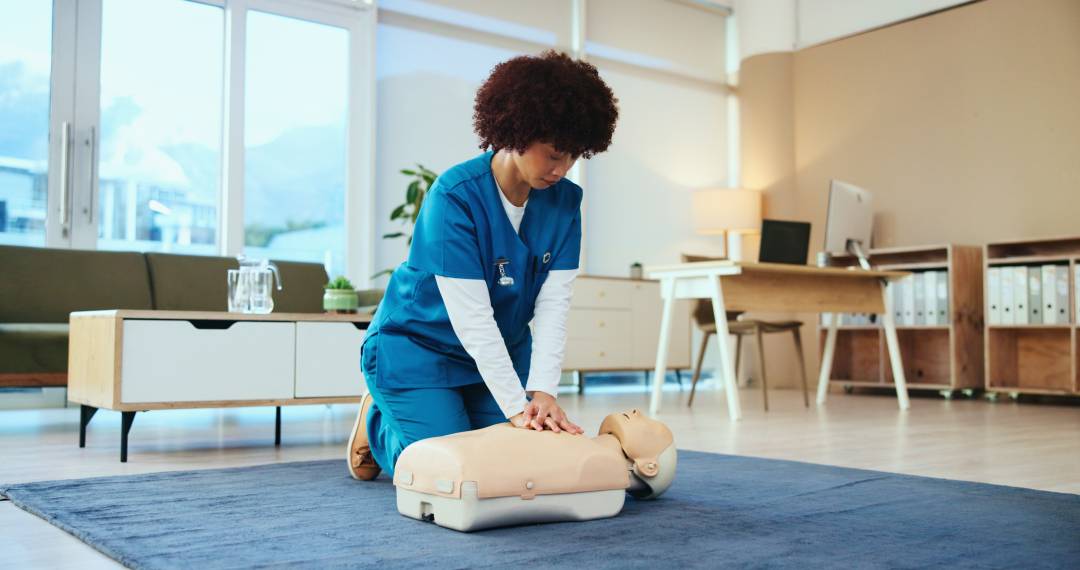Introduction
First Aid and CPR certifications are important for being prepared for emergencies, playing an important role when wanting to increase survival rates during medical emergencies. The American Heart Association (AHA) estimates that 70% of out-of-hospital cardiac arrest occurs at home, making it essential for caregivers and family members to be prepared. Taking action, like providing CPR, as soon as possible, can double or triple the chances of survival for the victim when timely before the emergency medical team arrives. In addition, a report prepared during 2020 by the Sudden Cardiac Arrest Foundation found that survival rates increased significantly when bystanders are trained to act quickly. Most professionals, caregivers, and responsible citizens recertify their First Aid and CPR certifications on a regular basis.
This article will investigate if it’s feasible to renew First Aid and CPR certification online without a skills assessment with hands-on skills, discussing the limitations, benefits, and main considerations when using online options.
Why CPR and First Aid Certification Matters
These certifications prepare individuals to respond to situations in emergencies appropriately. This life-saving, time-sensitive response can save lives, mitigate injury, and soothe the anguish of people in crisis at home, at work, or in public. The key benefits are:
⦁ Demonstrated preparedness to respond effectively and calmly to emergencies to reassure patients/customers/bystanders that you will remain calm under pressure when lives are really on the line, and you will know what to do without hesitation.
⦁ It will save lives with an immediate, competent emergency response. Training means you will be able to provide CPR, apply a dressing to a bleeding injury, or stabilize a person in shock until someone arrives to help.
⦁ It is the standard for healthcare, childcare, and fitness professionals. Many professions require certification as a policy or a legal requirement of hiring and protecting from liability at the extremes of the employment continuum.
⦁ Increased confidence to take decisive action when it matters most. Knowing how to respond in medical emergencies will eliminate panic and increase the chances of timely and effective interventions.
The Traditional Skills Test Requirement
CPR and First Aid classes have historically featured a required in-person skills examination. This way, participants can actually conduct CPR and critical first aid skills under professional guidance prior to obtaining certification.
Why It’s Important:
⦁ Validates hands-on life-saving skills competency. Testing ensures individuals can execute procedures like chest compressions or wound care effectively, beyond theoretical knowledge.
⦁ Gives instantaneous feedback to enhance technique. Teachers adjust hand placement, compression depth, and rescue breathing for optimal performance.
⦁ Complies with professional and workplace safety standards. Numerous healthcare and licensed occupations require legally mandated documented hands-on competence.
⦁ Imitates crisis situations to practice realistically. Pressure testing replicates actual crises, readying students for critical medicine situations.
Renewing CPR and First Aid Certification Online
Currently, several accredited providers have CPR and First Aid recertification programs online. A few of them allow you to renew without having to test a hands-on skill set, particularly if you don’t work in regulated healthcare industries. How It Works:
⦁ Take an online course reviewing current medical guidelines. They use video demonstrations, readings, and quizzes that focus on up-to-date best practices.
⦁ Pass a web-based knowledge test or a written exam. Students need to apply their understanding of CPR timelines, AED operation, and first aid treatment.
⦁ Immediately download a virtual certification card upon passing. Such a card may contain your name, course date, and expiration.
⦁ Check requirements when used in regulated occupations. Some occupations still call for documented hands-on assessment for licensure and liability.
Advantages of Online Certification Renewal
Online renewal courses provide convenience, flexibility, and affordability for professionals who are busy or live far from medical facilities. Online courses provide immediate access to revised emergency care guidelines without leaving the office or home. Primary Benefits:
⦁ Study at your own pace, anywhere, and on any schedule. Online courses provide 24/7 access, perfect for shift workers and distant learners.
⦁ Easier on the pocketbook than in-person classes. Digital courses are usually less expensive, saving money on registration fees and commuting.
⦁ Get up-to-date emergency care guidelines and procedures. Programs include the most current developments from acknowledged health organizations.
⦁ Instant issuance of certification upon course completion. No waiting for printed documents or on-site sign-offs; evidence is given instantly.
Things to Consider Before Choosing an Online Option
Not all online certifications in CPR and First Aid are acceptable to employers or professional boards. It’s important to ensure the program is accredited and check prerequisites prior to registration.
Important Things to Keep in Mind:
⦁ Check whether your employer is willing to accept online-only certifications. Some employers require blended or on-site testing for liability purposes.
⦁ See that credible organizations accredit the course. Recognized institutions include the AHA, Red Cross, and National Safety Council.
⦁ Ensure the required skills testing is still in your field. Some healthcare, childcare, and certain fitness jobs continue to demand practical testing.
⦁ Confirm course material addresses fundamental CPR and first aid techniques. Discussion points should encompass adult, child, and infant care, use of an AED, and dealing with basic emergencies.
Conclusion
You can recertify your CPR and First Aid online without taking a skills test in most non-regulated disciplines, providing a convenient alternative for busy professionals and caregivers. Online certification provides a convenient, flexible, and affordable way to stay ready in emergencies while adjusting for demanding schedules and geographic restrictions. It is still important to make sure that a reputable health and safety organization accredits the online course and that your licensing authority or employer accepts it. Choosing a solid, standards-driven program means that you will remain confident, capable, and totally ready to administer timely, lifesaving care when it is truly needed.
Read More: internet chicks: Guide To Online Work And Digital Influence










